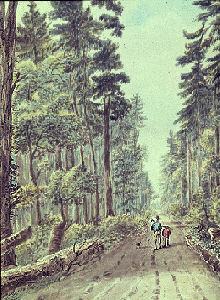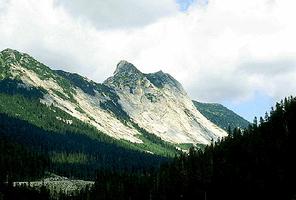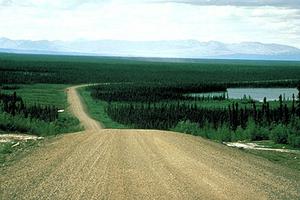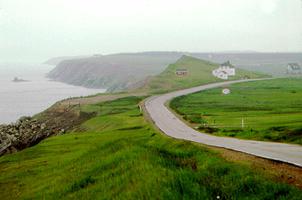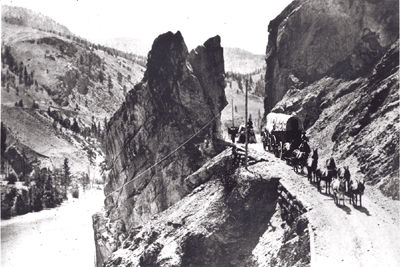Canada's first highways were the rivers and lakes used by Indigenous peoples, travelling by canoe in summer and following the frozen waterways in winter. (See also Birchbark Canoe; Dugout Canoe.) The water network was so practical that explorers, settlers and soldiers followed the example of the Indigenous peoples. (See also Coureurs des bois; Voyageurs.) To a greater extent than most other countries, Canada depends for its social, economic and political life on efficient communication and transportation. (See also Economy; Politics.)
History
Canada's first highways were the rivers and lakes used by Indigenous people, travelling by canoe in summer and following the frozen waterways in winter. (See also Birchbark Canoe; Dugout Canoe.) The water network was so practical that explorers, settlers and soldiers followed the example of the Indigenous people. (See also Coureurs des bois; Voyageurs.) There was negligible road development prior to the 19th century; the first graded road in Canada, built in 1606 by Samuel de Champlain, was a 16 km military road from Port-Royal to Digby Cape, Nova Scotia. By 1734 Québec City and Montreal were linked by a road and a carriage could be driven the 267 km in 4½ days. In the early days of New France, roads and bridges were the responsibility of a crown-appointed chief inspector, a system retained by the British until 1832. Roads were divided into 3 classes: main roads, 7.2 m wide; connecting roads to farms, 5.4 m wide; and back roads, built on orders of the seigneurs ( see Seigneurial System).
Early roads in British North America were built out of military necessity. For example, Yonge Street, which stretches 60 km from York and Lake Simcoe; built by the Queen's Rangers, under the orders of Lieutenant-Governor John Graves Simcoe, and Dundas Street from York to London, safely inland from Lake Erie (see Yonge Street – Governor Simcoe’s Military Road). State concern for roads set an early pattern. As early as 1801, the New Brunswick Assembly made regular grants for road construction (see New Brunswick).
In 1793 an Act of the first Parliament of Upper Canada placed all roads under the supervision of overseers, called pathmasters. Early road development was accomplished by a system of "statutory labour," which required settlers to maintain the road adjacent to their property or to work 3 to 12 days each year on road maintenance. Over time, the statutory labour system was commuted into payment of a fine in lieu of labour, creating the first source of funds for road expenditures. As road requirements developed beyond the capabilities of local orientation, toll roads were introduced.
An appropriation for roads was made in 1804 for a munificent £1000, which was doubled 12 years later. These early roads complemented rather than replaced water transport (see Transportation). Mostly little more than cleared paths, a few were planked or "corduroy" (made of logs laid side by side). Nevertheless, they provided valuable inland transportation (especially in winter), reduced costs and opened up new areas to settlement.
Travel by road in early Canada was difficult and often hazardous. The roads were so bad that most people preferred horseback or walking rather than vehicular transportation (see Horse). Settlers' vehicles were usually homemade and crude; wheels were cut from the round trunks of huge oak trees. Later came the Conestoga wagons for carrying heavy loads (as much as 9 m long, drawn by 6-horse teams) and then 4-wheeled buckboards. The elite of the new cities and towns of Lower Canada had the Calèche (open carriages) and the wealthy of Upper Canada and the Maritimes drove buggies. The stagecoach era began at the start of the 19th century and lasted more than 50 years. With it, in 1805, came the toll road and the turnpike trusts. Some of the turnpike companies controlled greater or lesser stretches of road, and the countryside was a network of toll roads for more than a century.
On some roads even a traveller on foot was charged a penny. In recent years, some provincial governments have revived the idea to help finance costly projects, such as the Laurentien autoroute north of Montreal and the Coquihalla highway in British Columbia connecting Hope and Kamloops. Some international crossings also charge tolls. At the peak of the stagecoach era, regular services for passengers and mail were run between all major cities and towns and into the United States. But travel was still an adventure in clumsy, uncomfortable vehicles, ranging from open wagons to ungainly carriages hung on leather springs. In winter they were mounted on runners and some carried wood stoves for warmth. The stagecoach era waned with the coming of the railways, and as the network of rails spread roads were used only for local travel ( see Railways, Track and Yards). Trunk roads deteriorated as maintenance expenditures were cut. With vast investments in railways, there was virtually no road building.
British Colombia's first road, from Esquimalt to Victoria, was built in 1854 by sailors of the Royal Navy. Four years later gold was discovered at Hope and hordes of prospectors poured through the Fraser and Thompson river valleys all the way to the Cariboo. A road was needed to serve the boom towns that had sprung up. Royal Engineers and private contractors, recruiting out-of-luck miners as their work force, built the Cariboo Road in 3 years at a cost of $2 million. It was one of the wonders of its age, blasted out of mountainsides, crossing gorges on suspension bridges and hanging over precipices on timbered trestles.
Road development came more slowly to the Prairies (see History and Settlement of the Canadian Prairies). There was little need for roads at first; the early pioneers used Indigenous trails, and over these rumbled the Red River Carts and the settlers' covered wagons known as "prairie schooners." Crossings at rivers were provided by fords or ferries. Most prairie development took place through the railway, with roads providing local transportation.
The road system in the North-West Territories, which included present-day Alberta and Saskatchewan, was administered from Regina from the early 1880s until the provinces were formed in 1905. The development of natural resources spurred road construction, first in Manitoba and later in the newer provinces.
Transportation development of the North received great impetus from the building of the Alaska Highway during the Second World War. Like early roads, it was built for military reasons, but it provided an economic link between the Yukon and the Peace River country. The 614 km Mackenzie Highway began as a winter road in 1938 and was completed to Hay River on the shore of Great Slave Lake after WWII and to Yellowknife in 1961. The cost-sharing Roads to Resources Program, unveiled by the Diefenbaker government in 1958, was designed to exploit the resources of the North (see John Diefenbaker). The volume of traffic has increased yearly as supplies, machinery and mining equipment are moved north and minerals, fish and furs south (see Mining; Fur Industry; Transportation in the North; ). However, all provinces participated in the program. In some, particularly the Atlantic provinces, the funds were spent on tourist development, e.g., upgrading and paving Cape Breton's Cabot Trail (see Cape Breton; Tourism). In 8 years, $145 million was spent on 6,400 km of new "roads with a future," the Government of Canada sharing 50% of the cost.
Automobile
The modern highway system dates from the introduction of the internal-combustion engine some 20 years after Confederation. (See also Automobile.) In 1898 John Moodie of Hamilton brought a one-cylinder Winton "horseless carriage" from the United States. Six years later a Ford assembly plant in Windsor, Ontario was built - and Canada's Automotive Industry was born (see Ford Motor Company of Canada Limited). In 1907 there were 2,131 cars registered in Canada, and by the outbreak of the First World War there were more than 50,000. Some efforts were made to improve inadequate roads and streets. In 1915 Ontario completed the construction, begun 5 years earlier, of a concrete highway from Toronto to Hamilton, the first in that province and one of the longest intercity concrete roads in the world. Canada's first provincial Department of Highways was created by Quebec in 1914. Two years later Ontario, which had had a provincial instructor in charge of roadmaking attached to the Department of Agriculture since 1896, formed its own separate highways department.
Through the 1920s cars became cheaper and their numbers multiplied; registration of motor vehicles increased from 408,790 to nearly 1.62 million by the end of the decade. Good roads associations, national and provincial, led the crusade for improved road travel, and expenditures on roads by all governments tripled (see Automobile Associations). By 1930 the annual outlay was $94 million. Methods and technology for building roads improved as horse-drawn scrapers and graders gave way to steam power for shovels and rollers (see Technology in Canada). However, road building in most provinces ceased and maintenance was reduced during the Great Depression and WWII as men and materials were urgently needed in the war effort. The few good paved roads that had been built were almost completely destroyed by heavy wartime traffic, particularly in industrial areas (see Industrialization in Canada). The "Last Spike" of the Canadian Pacific Railway was driven in 1885, but 61 years passed before a motor vehicle was driven across Canada. Brigadier R.A. Macfarlane and Kenneth MacGillivray made the journey in 9 days from Louisbourg, Cape Breton, to Victoria, British Columbia in 1946, 4 years before the Trans-Canada Highway was begun.
Post-WWII Development
Burgeoning road development in Canada and around the world left virtually no facet of economic or social life unchanged. With increasing efficiency and improving technology, road builders constructed highways and streets to accommodate automotive traffic ( see Automobile; Technology in Canada). Expenditures soared from $103.5 million in 1946 to $1.5 billion in 1966 and to $4.5 billion in 1986. Expenditures on roads and highways fell victim to cost-cutting efforts in the 1990s. Total expenditures by local governments on roads and streets reached $6.09 billion in 1990, then dropped slightly to $5.9 billion in 1992, peaking in 1995 at $6.6 billion and then cut to $6.03 billion in 1996. Provincial/territorial spending followed suit, with expenditures on highways reaching $6.1 billion in 1990, dropping to $5.8 billion in 1992, peaking at $6.2 billion in 1995 and dropping to $5.7 billion in 1997.
In 1946 there were 28,982 km of paved rural highways and 10,000 km of paved urban roads and streets. In 1966 this total had risen to 148,987 km, nearly two-thirds of which were rural highways. In 1985 the total amount, paved and unpaved, was 841,411 km. By 1995 Canada had a total of 901,903 km of public roadway comprising 442,408 km of gravel road, 301,348 km of paved road, 69,292 of surface treated road, 66,829 km of earth roads, 16,571 km of freeway and 5,455 km of roads classified as "other," e.g., winter roads. These changes have left a deep imprint on the Canadian landscape, ripping through the wilderness and transforming the urban environment with expressways, interchanges, and suburban sprawl, with ribbonlike development along the highways. ( See also Urban Transportation; Urban and Regional Planning.) Rural life has also been transformed, as trucks deliver necessities and livestock, fruit, vegetables and other agricultural products are conveyed to market (see Animal Agriculture; Fruit Cultivation; Agriculture and Food; Trucking Industry).
Engineering
Early traffic laws were very simple, concerned mostly with the marking of roads in winter by evergreen branches set in the snow. Later, sleigh bells on harnesses were used to warn of approaching vehicles when visibility was poor. Canada made two early notable contributions to North American road transportation. Highway numbering was introduced in 1920 in Manitoba, replacing the identifying-coloured bands painted on telephone poles.
In Ontario in 1930 an engineer experimented with dotted white lines down the centre of a road. Within three years they had become standard throughout the continent. Traffic engineers, experienced in planning and electronics, were eagerly sought by municipalities in the 1940s and 1950s to help untangle traffic snarls (see Engineering). In 1956 the Canadian Good Roads Association established a Council on Uniform Traffic Control Devices and 3 years later published the first manual of standard signs, signals and pavement markings. The association also launched a program of scholarships to help overcome the shortage of engineers qualified to use new techniques such as photogrammetry and computer programming (see Computer Science). Postgraduate studies began in Canada as the University of Alberta offered the first degree in road engineering in 1956.
Jurisdiction
Under the Constitution Act, 1867, the provinces were given almost complete responsibility for road building. By 1995 there were 655,892 km of public roadways under municipal jurisdiction, 230,930 under provincial jurisdiction and 15,082 under federal jurisdiction. Revenues from users - provincial motor-fuel taxes, the federal excise tax on gasoline, vehicle and driver licence fees, street-parking revenue and fines - have never been enough to cover expenditures (see Customs and Excise; Taxation in Canada). In 1996-1997 provincial/territorial licencing fees amounted to $2.6 billion, provincial/territorial fuel taxes were $5.6 billion and federal fuel taxes amounted to $4 billion. Federal monies are used to supplement provincial/territorial funds. Federal expenditures to Transport Canada in 1997-98 were estimated at $2.4 billion, excluding monies to the Canadian Transportation Agency, Transportation Safety Board, Civil Aviation Tribunal and transportation expenditures by other federal departments such as Fisheries and Oceans, Public Works and Government Services and Parks Canada. Large sums come from consolidated revenue, with the logic that efficient highway transportation benefits the entire economy.
Today the federal government is responsible for maintaining roads crossing federal property, such as national parks. The federal government is also involved in the administration of the National Highway System, which incorporates federal and provincial highways as well as their connections to American routes. Street systems in cities, towns and villages are the responsibility of municipalities, though sometimes subsidized by the provinces. In the peak years of urban freeway development, the high costs frequently brought provincial and municipal governments together in cost-sharing agreements. The escalating costs of equipment, materials and manpower for replacement, repairs and maintenance of older roads mean higher budgets. The cost of snow removal also adds millions of dollars to maintenance budgets (see Snow Blower). In the 1990s era of fiscal restraint and cost-cutting, road and highway budgets suffered as provinces, cities and towns reduced operating costs.

 Share on Facebook
Share on Facebook Share on X
Share on X Share by Email
Share by Email Share on Google Classroom
Share on Google Classroom
